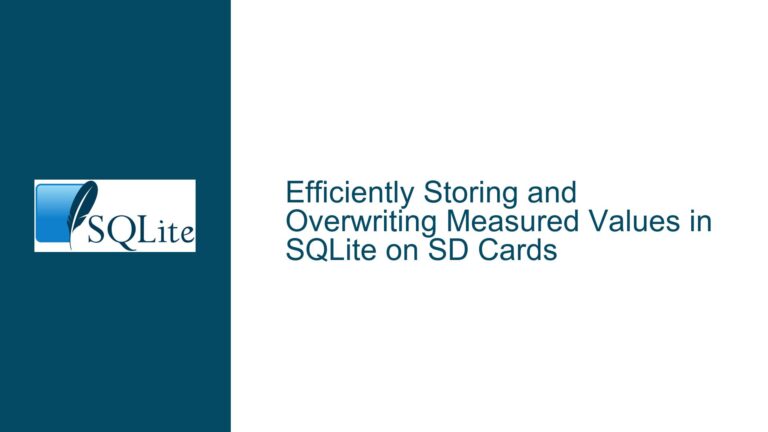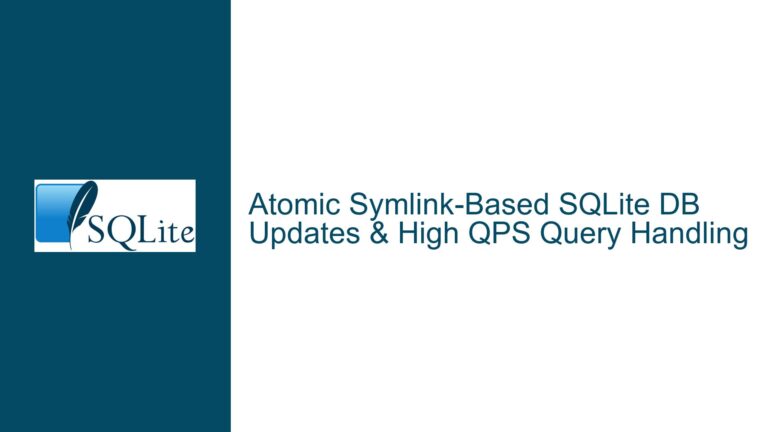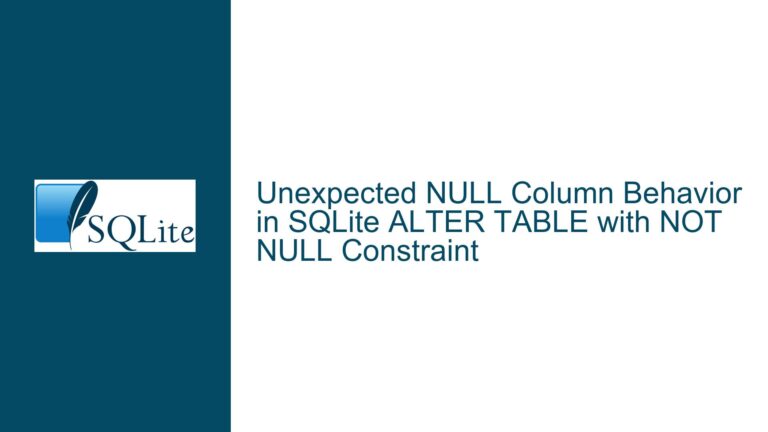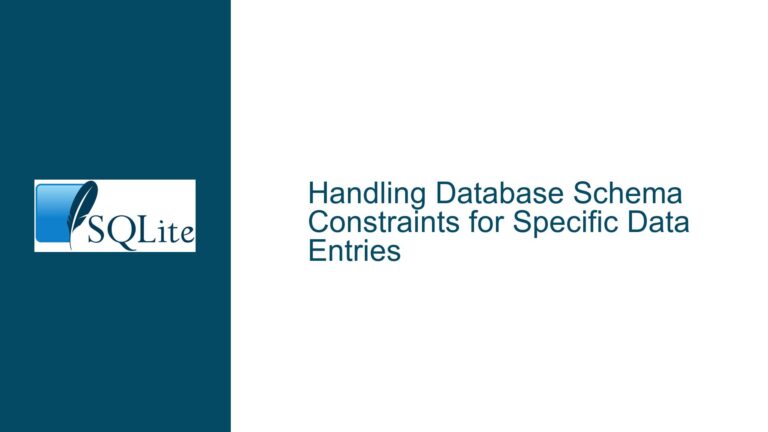Resolving “Unsafe Use of fct()” When Implementing UDFs in Generated Columns
Issue Overview: Custom Function Triggers "Unsafe Use" Error in Generated Column Definition
When attempting to use a user-defined function (UDF) within a generated column definition in SQLite, developers may encounter the error message "unsafe use of fct()", even when the function operates correctly in standalone SELECT queries. This error indicates that SQLite’s safety mechanisms have flagged the function as potentially unsafe for use in schema definitions. The core conflict arises from SQLite’s security model for schema validation, which imposes strict requirements on functions used in persistent schema elements like generated columns, triggers, and views.
The problem is rooted in SQLite’s distinction between deterministic and innocuous functions. While the SQLITE_DETERMINISTIC flag declares that a function will always produce the same output for identical inputs, it does not inherently certify the function as safe for use in schema definitions. Schema-level usage requires additional validation through either the SQLITE_INNOCUOUS flag or configuration of the database’s trusted schema mode. The error occurs because SQLite enforces these safety checks by default to prevent malicious or accidental schema corruption through functions that might expose vulnerabilities when executed in a trusted context.
Possible Causes: Security Constraints on UDFs in Schema Definitions
1. Missing SQLITE_INNOCUOUS Flag on UDF Registration
SQLite categorizes functions as "safe" or "unsafe" based on their registration flags. When a function is used in a generated column, SQLite requires it to be marked as innocuous unless the database operates in trusted schema mode. The SQLITE_INNOCUOUS flag explicitly signals that the function does not perform operations that could compromise database integrity, such as modifying data, accessing external resources, or introducing side effects. If this flag is absent during function registration, SQLite defaults to treating the function as unsafe for schema definitions.
2. Trusted Schema Mode Disabled (PRAGMA trusted_schema=0)
By default, SQLite enables a security feature called trusted_schema, which restricts the use of non-innocuous functions in schema definitions. When trusted_schema is set to 0 (the default), SQLite assumes that the schema might be influenced by untrusted sources (e.g., user input or external files) and enforces stricter validation. Functions not marked as innocuous are blocked from participating in generated columns, triggers, or views to prevent potential exploits.
3. Function Implementation Lacks Deterministic Guarantees
While the immediate error relates to safety rather than determinism, any inconsistency in the function’s deterministic behavior can compound validation failures. If a function is registered as deterministic but exhibits non-deterministic behavior (e.g., relying on random numbers or external state), SQLite’s internal consistency checks might trigger secondary errors, though this is less likely to produce the specific "unsafe use" message.
Troubleshooting Steps, Solutions & Fixes: Configuring UDF Safety for Generated Columns
Step 1: Validate UDF Registration Flags
The function must be registered with both SQLITE_DETERMINISTIC and SQLITE_INNOCUOUS flags to satisfy SQLite’s safety requirements for generated columns. Modify the sqlite3_create_function_v2 call to include these flags:
sqlite3_create_function_v2(
db,
"fct",
-1,
SQLITE_UTF8 | SQLITE_DETERMINISTIC | SQLITE_INNOCUOUS,
0,
fct, // Ensure correct function pointer syntax (no &)
0,
0,
0
);
Key Considerations:
- Function Pointer Syntax: In C, the function name (
fct) serves as its address. Using&fctis redundant and potentially error-prone in some compilers, though it often works. Standard practice is to passfctdirectly. - Security Implications of SQLITE_INNOCUOUS: Marking a function as innocuous asserts that it cannot be exploited for malicious purposes, even if called by an attacker-controlled schema. Audit the function’s code to ensure it does not:
- Modify the database (e.g., execute
INSERT,UPDATE). - Access external systems (files, networks).
- Depend on global variables or static state.
- Expose sensitive information.
- Modify the database (e.g., execute
Step 2: Configure Trusted Schema Mode
If marking the function as innocuous is undesirable due to security concerns, enable trusted schema mode at the database level. This bypasses the innocuous requirement but assumes the schema is trusted:
PRAGMA trusted_schema = 1;
Security Trade-Offs:
- Trusted Schema Risks: Enabling this pragma disables SQLite’s safeguards against schema injection attacks. Only use this in environments where the schema is fully controlled by trusted sources (e.g., internal applications with no user-generated schema components).
- Persistence: The
trusted_schemasetting is not persisted across database sessions. It must be set programmatically each time the database connection is opened.
Step 3: Verify Deterministic Behavior
Although the error message emphasizes safety, ensure the function is genuinely deterministic. Non-deterministic functions marked as deterministic can lead to data corruption in generated columns. Test the function with varied inputs to confirm consistent output:
SELECT fct(6, 0, 63) AS output1, fct(6, 0, 63) AS output2;
-- Both outputs must be identical
Debugging Non-Determinism:
- Review the function’s reliance on external state (e.g., system time, random seeds).
- Check for mutable static variables in the UDF’s C implementation.
Step 4: Recompile and Reload the SQLite Extension
After modifying the UDF registration flags, recompile the SQLite extension or amalgamation and reload it into the database environment. For CLI testing, restart the sqlite3 session to ensure the updated function registration takes effect.
Step 5: Test Generated Column Creation
With the corrected flags and configuration, attempt to create the generated column again:
CREATE TABLE x(
id INTEGER,
rid INTEGER GENERATED ALWAYS AS (fct(id, 0, 63)) VIRTUAL
);
Schema Validation Notes:
- Use
VIRTUALfor generated columns computed on-read orSTOREDfor on-write persistence, depending on performance requirements. - If the error persists, inspect the SQLite error log for additional context or compile SQLite with debugging symbols to trace schema validation logic.
Step 6: Audit Function Usage in Production Environments
Before deploying the solution, conduct a security review of the UDF’s usage in generated columns:
- Input Sanitization: Ensure the
idcolumn or other inputs tofct()cannot be manipulated to trigger unexpected behavior. - Privilege Management: Restrict database write privileges to prevent unauthorized schema modifications that might leverage the UDF.
Alternative Approach: Wrapper Functions for Safety Isolation
If the UDF cannot be safely marked as innocuous, consider encapsulating its logic within a view or stored procedure that sanitizes inputs before invoking the function. This adds a layer of indirection to mitigate direct exposure in schema definitions.
CREATE VIEW safe_x AS
SELECT id, fct(id, 0, 63) AS rid
FROM x;
Limitations: Views do not persist data like generated columns and require application logic to handle computed values at query time.
Final Recommendations
- Prefer SQLITE_INNOCUOUS Over trusted_schema: Where possible, mark safe functions as innocuous rather than disabling schema validation globally. This maintains security for other schema elements.
- Document Function Safety: Maintain internal documentation for all UDFs, explicitly noting their deterministic and innocuous status to aid future debugging.
- Monitor SQLite Updates: Stay informed about changes to SQLite’s security model, as future versions might introduce additional flags or alter validation logic.
By aligning UDF registration with SQLite’s security expectations and rigorously auditing function behavior, developers can safely integrate custom logic into generated columns while mitigating the risks of schema-level exploits.






